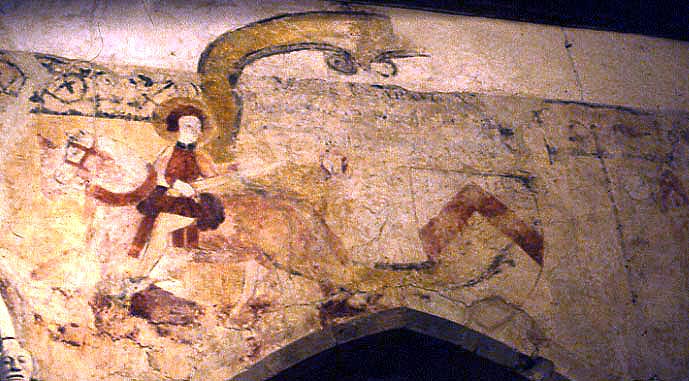Chalgrave, Bedfordshire (†St Albans) c.1400
St Martin Dividing his Cloak

St Martin, like St Nicholas a worker of wonders¹, was once as least as popular in the English church, but there are very few paintings of him left now. The moralizing story of his cutting his cloak in half to share it with a beggar has obvious appeal and here the scene is painted over the south door at Chalgrave. Martin, astride his horse and wearing his cloak, turns backwards in his saddle to slice through it with his large sword. The lower half drapes itself over his horse’s rump and is hard to see, but the upper half flies dramatically upwards. The beggar is probably standing just to the right of the horse – there is a patch of pigment that seems to be his head, but the rest of the figure is gone completely.
Chalgrave is very fully painted, but the paintings are of various dates from the late 13th to the 18th centuries. There is much painted heraldry (one painted shield is visible in the photograph) and texts superimposed on earlier paintings.
There is another, very early, painting of St Martin at Wareham in Dorset, and a rather faint example of Martin dividing his cloak at Martley in Worcestershire (on here soon). Another, said to be dilapidated but of about the same date as Chalgrave, is recorded at Nassington in Northamptonshire, although I doubt if it is still visible. There may be others, but the eight examples recorded by Keyser in 1888² have certainly dwindled to a fraction of that number now.
¹ And a moraliser himself according to the Knight de la Tour-Landry in his plentiful advice to his daughters on behaviour. He gives St Martin as his source for stories about the dangers of gossiping in church (as various women are pictured doing in these pages). [The Book of the Knight of the Tower, 1371, Early English Texts Society, 41]. Martin, as Bishop of Tours in central France, was certainly renowned as a great visitor of the churches in his Diocese and a rooter-out of vestigial paganism, so the attribution may be well-founded.
² (see Bibliography)